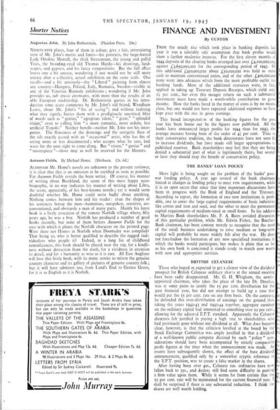Shorter Notices
Augustus John. By John Rothenstein. (Phaidon Press. 20s.)
NINETY—FIVE plates, four of them in colour, give a fair, entertaining view of Mr. John's merits and limits—his portraits, the large-hatted Lady Ottoline Morrell, the thick Stresemann, the young and pallid Yeats, the brooding-eyed old Thomas Hardy—his drawings, land- scapes, and gypsies, and his fancy compositions. But the full effect leaves one a bit uneasy, wondering if one would not be still more uneasy after a collective, actual exhibition on the same scale. One recalls—and a bit anxiously—the " Liberal " painting from almost any country—Hungary, Poland, Italy, Rumania, Sweden—visible in any of the Venetian Biennale exhibitions ; wondering if Mr. John provides -us, sub specie eternitatis, with more than the results of an able European studentship. Dr. Rothenstein quotes in his intro- duction some acute comments by Mr. John's old friend, Wyndham Lewis, about Mr. John's " fits of seeing "; and without realising what they signify, buries them with a prodigiously uncritical blitz of words such as " genius," " egregious talent," " great," " splendid vision," even to calling him " a more romantic, more ardent, less artificial Tiepolo." Neither benefit—neither Mr. John nor his inter- preter. The flimsiness of the drawings and the energetic flare of the oils exactly accord with an " occasional " artist, who has fits of seeing more or less disconnected ; who accepts what he sees, and waits for the next sight to come along. But " vision," " genius " and " masterpiece "—those may as well be reserved for the Masters.


























 Previous page
Previous page